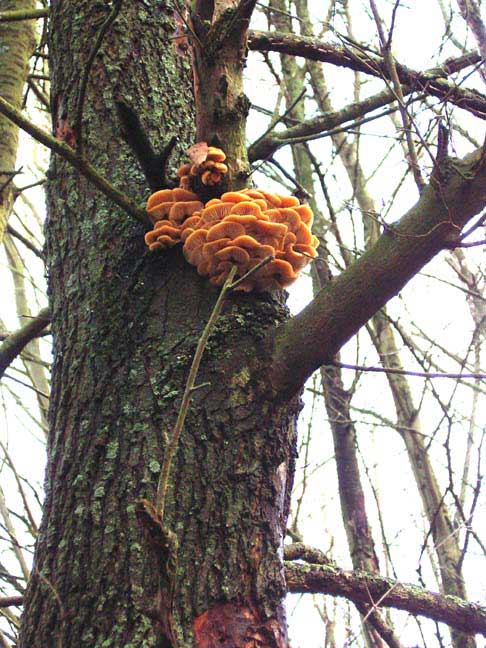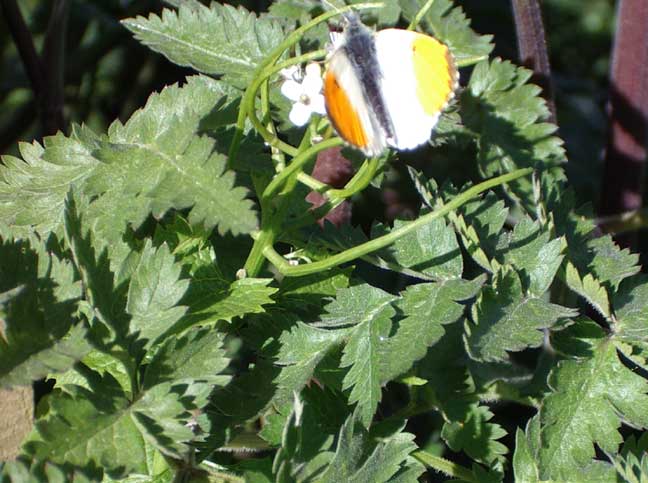 Nothing
much was moving, except that I noticed that the Bittersweet
berries were particularly plump.
Nothing
much was moving, except that I noticed that the Bittersweet
berries were particularly plump.
3 September
2004
 Nothing
much was moving, except that I noticed that the Bittersweet
berries were particularly plump.
Nothing
much was moving, except that I noticed that the Bittersweet
berries were particularly plump.
19
August 2004
A
Snowberry
has been planted on the Lancing College side of
the road by the Cuckoo's Corner car park.
 |
 |
 |
12
May 2004
Scores
of House Martins
filled the sky over the Adur Levels, notably over the fields north of Cuckoo's
Corner.
 28
April 2004
28
April 2004
There
was a handsome Peacock Butterfly
at Cuckoo's Corner.
31
March 2004
I
saw my
first bright yellow Brimstone Butterfly
of the year at Cuckoo's Corner. It was very distinctive in flight, but
when I looked around I could not find it again.
26
March 2004
Quite
the most magnificent bird I have ever seen in the Adur area, a pale fawnish-brown
Barn
Owl flew majestically in a straight line
above the Ricardo test track opposite the Sussex Pad Hotel (at the southern
end of the Coombes Road) and then veered into the cover of the trees. The
bird flew at 4:45 pm GMT
in bright sunshine so the view was far from fleeting. I was struck by the
size of this bird as it appeared much bigger than expected, especially
its head which was looking in my direction. (The book size says it is no
bigger than a Kestrel.)
Moorhens
seemed to more numerous than in previous years, a handful noted on the
ploughed fields to the south-east of Cuckoo's Corner. For virtually the
whole of this month there has been a score or more Moorhens
in the private (Lancing College) field next to Ladywell Stream on the west
side of the Coombes Road (see the photograph
above).
17
March 2004
Two
pairs of Great Spotted Woodpeckers
chased
their partners around the tree tops opposite Cuckoo's Corner on the Coombes
road. They made a tremendous commotion as they performed their antics,
with a rattling trill-like call that was repeated at regular intervals.
At times it seemed if two males were competing over one female and at another
time, it seemed that there were two separate pairs. This was the first
time I had seen more than one of these woodpeckers at the same time. There
woodpeckers chased each other up the tree trunks and flew from the larger
branches to another tall tree seen amongst the bare branches until they
were hidden amongst the ivy. There were a mixture of mature and decaying
trees and this would seem a likely breeding area for these attractive birds.
There
was a lot of bird song along the Coombes road, one call a very harsh single
squeal that stood out amongst the melodies and clicking calls. I have no
idea what bird can make such a noise?
14
March 2004
Three
white rumped deer were spotted in the fields overlooked by Lancing College
and close to Ricardo's
test strip (east of the Coombes road at its traffic lights junction with
the A27) at around 10:00 am.
Roe
Deer are frequently seen around the Adur
Levels and these fitted the book description.
February
2004
1 January 2004

Clumps
of Velvet Shank,
Flammulina
velutipes fungus were growing
on at least three Elm
trees to the north of Cuckoo's Corner.
This
is a typical species of late autumn throughout the winter. It is a remarkable
species since it has its own built in antifreeze and can go through frosts
unfazed and resume dropping spores immediately afterwards. Indeed, its
growth and spore production are stimulated by cold.
Fungi
of Shoreham (with more images and information)
Adur
Fungi: Fruiting Bodies (Monthly Guide)
Fungi
of the British Isles (Yahoo Group)
Adur
Nature Notes (January 2004)
13
November 2003
In
half an hours slow cycle ride from New Salts Farm to Cuckoo's Corner (via
Shoreham Airport), I must have spotted about twenty Moorhens,
in the fields with cows and in drainage ditches and small overgrown streams.
This is more than usual, although this water bird hides amongst the reeds
and they may just have been venturing out and it does not necessarily reflect
increasing numbers.
 |
 |
|
|
|
As
dusk drew in, the estimated count of Lapwings
flying south over the River Adur near Cuckoo's Corner (on the Coombes Road)
was 300.
There
were also two fleeting glimpses of hawks, the first flying along the Coombes
Road by Cuckoo's Corner was probably a female
Sparrowhawk.
The
second one, a couple of minutes later as the light faded, looked like a
male
Sparrowhawk that flew very low over the field
next to the river that was seen from the gate separating Cuckoo's Corner
from the towpath. Subsequent observations
of a hawk on the dull afternoon of 20 November
2003 seem to indicate that it was more likely
to be a female Kestrel, although the bird persistently refused to
hover.
31
October 2003
A
small flock of Long-tailed Tits
were a pleasant attraction at Cuckoo's Corner (on the Coombes Road), favouring
a Sycamore Tree near the new swing gate between the towpath and the car
park, but also venturing into the taller trees where a Greater
Spotted Woodpecker was clearly seen on
the side of a tree trunk.
8 October
2003
Two
Kingfishers
and two Water Rails,
Rallus
aquaticus, were seen near Cuckoo's
Corner, on the Coombes Road. This is assumed to be by the freshwater Ladywell
Stream.
10
July 2003
The
towpath from Old Shoreham Toll Bridge
north to Cuckoo's Corner on the western side of the River Adur was graced
by a Grey Heron.
Butterflies
fluttered in the hot sun with a large handful of Small
White Butterflies,
Red
Admirals and Meadow
Browns, plus more than one Small
Tortoiseshell. North of Cuckoo's Corner,
a Pheasant
strutted in the road, and scuttled into the heavy roadside undergrowth
at my approach.
 |
 |
At
Cuckoo's
Corner, the flash of orange and white
of the male Orange Tip Butterfly was
sudden and unmistakable. There were a couple of the larger all-white females
as well. From the trees on the Lancing College side of the road, a Cuckoo
called just once.
The
drainage ditch running north from Cuckoo's Corner was choked with floating
weeds or algae. Scores of Small Tortoiseshell
Butterflies, mostly faded, fluttered over
the grasses and plants by the stream's edge.
 22
January 2002
22
January 2002
Gliding
less than a metre above the road surface, south of Cuckoo's Corner (TQ
201 064), a male Sparrowhawk
flew at least 20 metres along the road before veering suddenly in the hedgerow
on the right. It was identified as a male by its slate-bluish colour, and
as a Sparrowhawk by its behaviour including the fanning of its tail as
it swerved adeptly between the bare hedgerow branches in a way that would
not be common for the Kestrel. A Kestrel,
a regular sight on waste land, had spent some time gliding and hovering
near Old Shoreham on the east side of the Adur,
so I was able to contrast the two falcons.
4 July
2001
A
Great Spotted Woodpecker was spotted on
the Coombes road between Cuckoo's Corner and the Ladywell Stream, in a
tree at the bottom of the private path leading to Lancing College (TQ 200
069).
15
November 2000
Cuckoo's
Corner is a lay-by a half mile so down
the Coombes Road from the A27 turn off for Lancing College and the Sussex
Pad. It has a collection of old trees which provide a magnet for birds.
A flock of about 50 Long-tailed
Tits were singing in the lower branches
of the ivy adorned 12 metre + high trees. This bird is not a titmouse at
all and is appreciably smaller than a Pied Wagtail, they actually
looked much smaller (apart from the long tail) than the Wrens
which
all shared the branches, and there was a Chaffinch
in the understorey of evergreen vegetation.